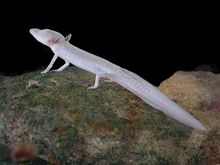
Troglomorphism is the morphological adaptation of an animal to living in the constant darkness of caves, characterised by features such as loss of pigment, reduced eyesight or blindness, and frequently with attenuated bodies or appendages. The terms troglobitic, stygobitic, stygofauna, troglofauna, and hypogean or hypogeic, are often used for cave-dwelling organisms.[1]
Troglomorphism occurs in molluscs, velvet worms, arachnids, myriapods, crustaceans, insects, fish, amphibians (notably cave salamanders) and reptiles. To date no mammals or birds have been found to live exclusively in caves. Pickerel frogs are classed as either trogloxenes, or possibly troglophiles. The first Troglobiont to be described was Leptodirus hochenwartii.[2]
- ^ "FishBase Glossary". Archived from the original on 23 September 2015. Retrieved 19 October 2016.
- ^ Culver, David C.; Pipan, Tanja (2007), "Subterranean Ecosystems", Encyclopedia of Biodiversity, Elsevier, pp. 1–19, doi:10.1016/b0-12-226865-2/00262-5, ISBN 978-0-12-226865-6, archived from the original on 2018-06-27, retrieved 2023-03-01